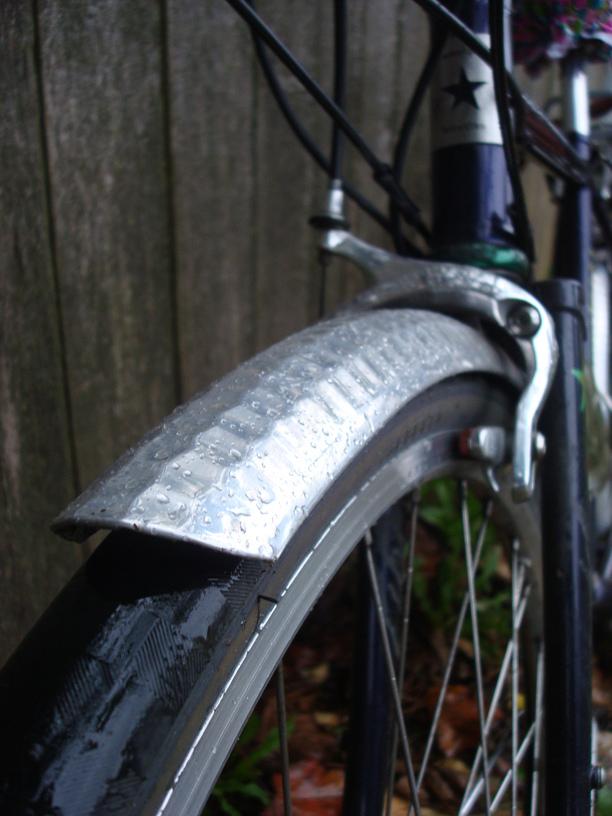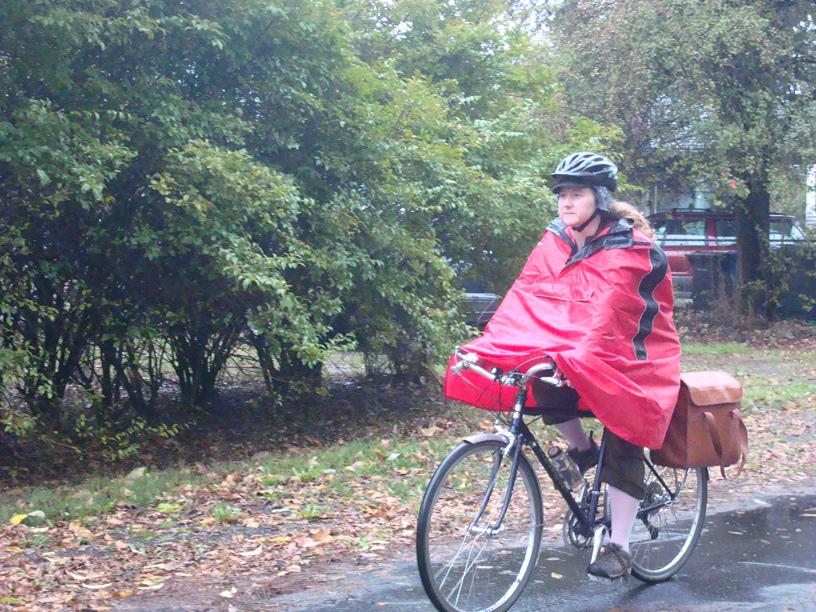Winter Tips from a Rain Expert
Winter: it’s coming, whether we like it or not.
Many bike travelers like to keep their chops up in winter by commuting or overnighting to cabins, and why not? Once you get the hang of it, winter biking can be pretty sweet.
Here in the Pacific Northwest, winter means lots of rain. As a native-born Portlander who has been biking seriously since 1999, I think of myself as a bit of a rain expert. Today I’d like to share my field-tested tips on becoming a happy winter cyclist.
On Your Body

A cyclist’s two best friends in winter are raingear and wool.
I’ve been wearing my Showers Pass raingear since 2008, and it’s still serving me well. In fact, one of my favorite parts of biking in winter is wearing my rain jacket – it has a chest pocket and I can situate my iPhone to listen to music sans headphones while I ride.
Even when it’s not raining, good raingear will help keep you insulated and warm. One January morning when it was 15º F, I did just fine on my hour-long commute wearing an extra layer of wool under my raingear – until I stopped at an outdoor gathering. In just a few minutes the extra heat was gone, and I was miserable. The point? It’s very possible to keep warm while biking by relying on an extra layer and your self-generated body heat. But don’t stop!
If you dislike technical fabrics or standard raingear sizing doesn’t fit, another option is to get yourself a wool peacoat. It takes a while to dry off once it’s wet, but it will keep you warm in the meantime. And the weight of all that wet wool may give your shoulders a workout as well.
Once you discover quality wool clothing, you’ll never want to wear anything else. Wool insulates you even when it’s wet, and it comes in a variety of fabric weights. It’s priced according to its amazingness, so if you’re nervous about the investment, start small with a pair of Smartwool socks or nab a wool sweater at your local thrift store.
On your head, a good wool cap will help keep heat in your body. Little Package makes great wool caps designed to fit under your helmet (including some models with an ear cover you can flip down when needed). The visor on caps also keeps rain from getting in your eyes as you ride. If your ears tend to get cold, consider looking for a pair of Helmuffs, which slip on to your helmet straps.
Good gloves make a huge difference as well—for the coldest days I recommend Pearl Izumi’s lobster gloves. I’ve also got a pair of Smartwool Cozy Gloves, and Windstopper Gloves for rainy days. Depending on the weather and other circumstances, I’ll choose which gloves will best fit the ride each morning.
On Your Bike

Your bike’s two best friends in wintertime are tires and fenders.
There are some great tires available for adverse road conditions. In rainy Portland, Continental Ultra Gatorskins and Schwalbe Marathons are quite popular. My bike has a non-standard wheel size, so I’m currently riding Nifty Swifties, which have a stylish checkerboard tread pattern. If you ride in an icy or snowy region (or you’d like to be really prepared) you can even find studded bike tires and bike tire chains (check your local bike shop before you shop online)!
Fenders are a must in areas where there’s a lot of water on the ground. A rear fender will prevent the dreaded “freshman stripe,” and a front fender will keep water from spraying onto your pants and shoes. (Wearing a pair of waterproof shoes or shoe covers doesn’t hurt.) If you’re a seasoned touring cyclist you likely already have fenders. If not, Planet Bike offers some low-cost fender options.
A detail that many of my fellow rain experts overlook is keeping your saddle dry. Sometimes it’s not raining enough to necessitate rain pants, but sitting on a wet saddle isn’t very inviting. Consider carrying a plastic bag or shower cap around to cover your saddle while you’re off the bike. You can even store it between the rails underneath when you ride!
Lighting
Shorter days and dark rain clouds mean a good lighting system is imperative! If you primarily ride in suburban or rural areas, I’d recommend going as bright as you can, with a rechargeable battery. (Heck, I recommend that even if you’re in the city.) I’ve been using the MiNewt Dual and Planet Bike SuperFlash since 2007, but the Light and Motion 550 is tempting for the next time I need a light. The holidays are a great time to gift a new lighting system to the special cyclist in your life.

Caution
Using your brain is also imperative in winter. After all, keeping your toes warm and dry won’t mean much if you crash. When the road is wet, always allow for increased braking distance. Ride predictably, defensively, and safely. Remember that metal (railroad tracks, manhole covers) is extra slippery when wet! If snow and ice are more likely than rain in your area, be sure to hook into the community at IceBike.
Riding in the rain can still be a joy when you equip your bike and body for the weather. Accepting the rain and adequately bracing yourself for it can be liberating. This winter, I hope you find yourself undaunted by rain when you need to escape the stuffy house for a few hours to get on the road. Soggy travels, friends!

